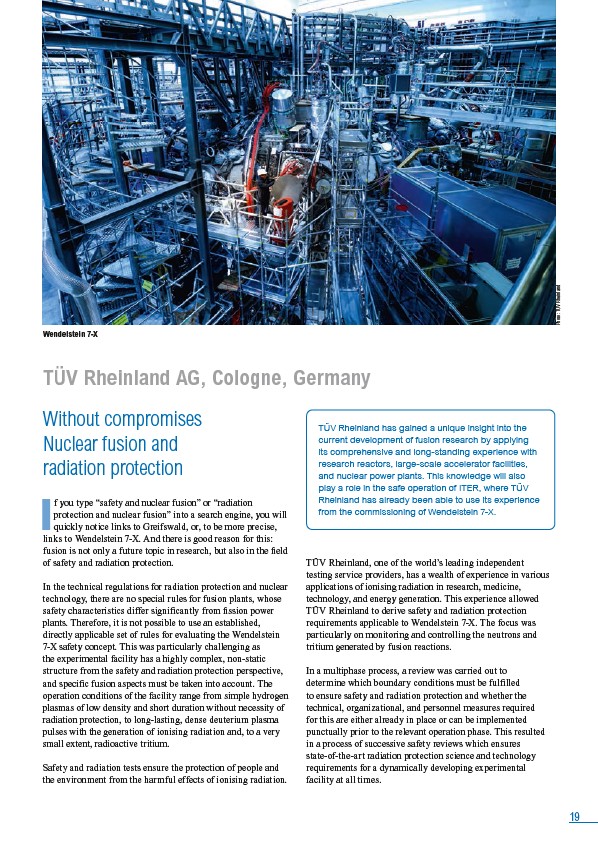
19
TÜV Rheinland AG, Cologne, Germany
Without compromises
Nuclear fusion and
radiation protection
If you type “safety and nuclear fusion” or “radiation
protection and nuclear fusion” into a search engine, you will
quickly notice links to Greifswald, or, to be more precise,
links to Wendelstein 7-X. And there is good reason for this:
fusion is not only a future topic in research, but also in the field
of safety and radiation protection.
In the technical regulations for radiation protection and nuclear
technology, there are no special rules for fusion plants, whose
safety characteristics differ significantly from fission power
plants. Therefore, it is not possible to use an established,
directly applicable set of rules for evaluating the Wendelstein
7-X safety concept. This was particularly challenging as
the experimental facility has a highly complex, non-static
structure from the safety and radiation protection perspective,
and specific fusion aspects must be taken into account. The
operation conditions of the facility range from simple hydrogen
plasmas of low density and short duration without necessity of
radiation protection, to long-lasting, dense deuterium plasma
pulses with the generation of ionising radiation and, to a very
small extent, radioactive tritium.
Safety and radiation tests ensure the protection of people and
the environment from the harmful effects of ionising radiation.
TÜV Rheinland has gained a unique insight into the
current development of fusion research by applying
its comprehensive and long-standing experience with
research reactors, large-scale accelerator facilities,
and nuclear power plants. This knowledge will also
play a role in the safe operation of ITER, where TÜV
Rheinland has already been able to use its experience
from the commissioning of Wendelstein 7-X.
TÜV Rheinland, one of the world’s leading independent
testing service providers, has a wealth of experience in various
applications of ionising radiation in research, medicine,
technology, and energy generation. This experience allowed
TÜV Rheinland to derive safety and radiation protection
requirements applicable to Wendelstein 7-X. The focus was
particularly on monitoring and controlling the neutrons and
tritium generated by fusion reactions.
In a multiphase process, a review was carried out to
determine which boundary conditions must be fulfilled
to ensure safety and radiation protection and whether the
technical, organizational, and personnel measures required
for this are either already in place or can be implemented
punctually prior to the relevant operation phase. This resulted
in a process of successive safety reviews which ensures
state-of-the-art radiation protection science and technology
requirements for a dynamically developing experimental
facility at all times.
Photo: TÜV Rheinland
Wendelstein 7-X